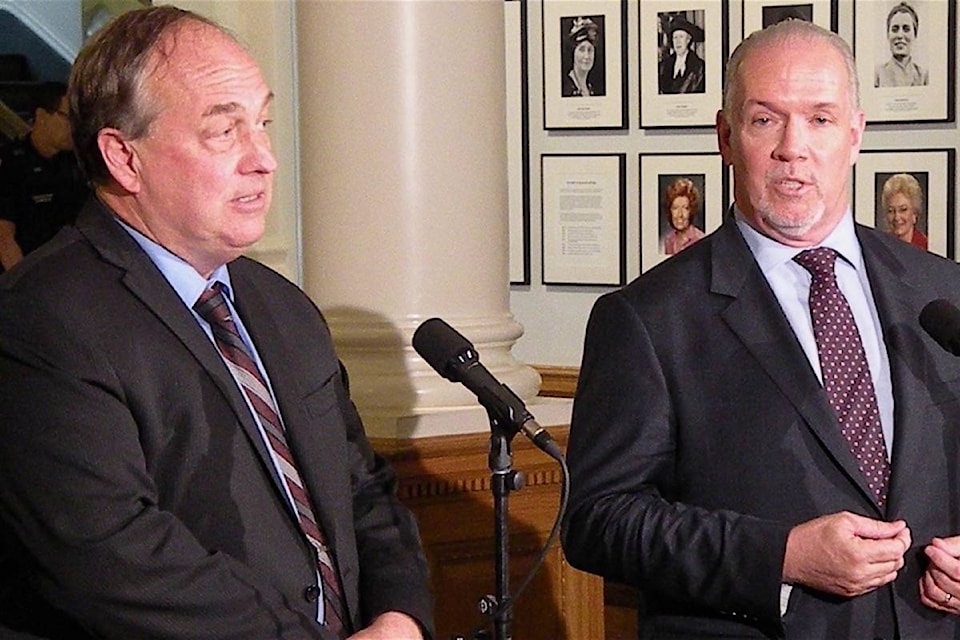The talking heads are leaning into it, B.C. Greens are actively lobbying for it, and the independents say it's a crucial part of their appeal
But what exactly is a minority government and how does strategic voting fit in as parties prepare for Saturday's B.C. election and beyond.
Parties need to win at least 47 out of B.C.'s 93 ridings to form a majority government. A minority or hung parliament occurs if no single party is able to reach that magic number of seats.
The last B.C. minority government happened in 2017 when the B.C. Liberals under Christy Clark won 43 seats, one short of a majority. The B.C. NDP under John Horgan won 41, while the B.C. Greens under Andrew Weaver claimed the other three.
Unwritten, legally non-enforceable but universally accepted convention, meant Clark would be premier until she had lost the 'confidence' of the legislature. That happened in late June after a majority voted against her government's speech from the throne. This opened the door for Horgan to form a minority government with the support of the three B.C. Greens after he and Weaver had negotiated a confidence-and-supply agreement. Clark had also sought the support of the B.C. Greens but failed to secure it.
Political observers say a similar scenario is possible given the closeness of the polls and the potential for Green or independent candidates to impact the seat count for the major parties. B.C. Greens leader Sonia Furstenau has acknowledged the party won't form government, but have actively lobbied for a repeat of 2017.
"During the minority government we had a glimpse of what we could have instead — a proactive, collaborative legislature that worked hard to get things done," Furstenau said.
Some experts disagree. Minority governments — both provincially and federally — have produced their share of political drama because the governing party cannot count on getting its agenda through.
Voters cannot choose a 'majority' or a 'minority' government. Either is an aggregate outcome of the 93 separate votes being held in individual ridings. That is where strategic voting comes in.
Starting last week, the B.C. NDP has raised the spectre of a strong Green showing in key ridings paving the path for a Conservative majority. Speaking last Sunday in Squamish in the riding of West Vancouver-Sea to Sky, which the B.C. Greens have targeted for a pick-up, B.C. NDP Leader David Eby openly appealed to Green voters.
“We share a lot of values with the Greens, particularly on tackling climate change," Eby said. "But this election is very close, and there’s so much on the line. (Conservative leader) John Rustad is a threat to the things we all care about. If you voted Green in the past, I’m inviting you to join us in this election – so together we can continue strengthening healthcare, tackling the housing crisis, and acting on climate change.”
Furstenau criticized the move.
"Throughout his campaign, Eby has focused on telling people not to vote for the B.C. Conservatives, and now he’s telling people not to vote for the B.C Greens," he said. "What he’s failed to demonstrate is why British Columbians should vote for the B.C. NDP."
Eby repeated this appeal Wednesday during a campaign stop in Nanaimo, reaching out to former B.C. Liberal voters or past supporters of B.C. United. He rejected the idea that New Democrats can stop a Conservative majority by voting for strong independents in ridings where the NDP is weak.
"There is only one party that is running in every constituency in British Columbia that can stop what the Conservatives have planned for our provinces and that is the B.C. NDP. The independents can't do it, the Greens can't do, only the B.C. NDP."
Conservatives, meanwhile, have never been shy about their stated ideological flexibility.
“It’s not about being Conservative or Liberal or NDP or Green," Rustad said in the fall of 2023. "We are attracting people from across the political spectrum because we are taking this approach, because we are fighting for the average, every-day person.”
But the party also faces challenges in key areas of B.C. from independents, including northern B.C. and the Okanagan, where a strong slate of independent candidates left over from the B.C. United campaign — some of them incumbent MLAs — could deny provincial Conservatives seats which they need for an overall majority.
Speaking in Kelowna earlier this month, Rustad said the possibility of vote-splitting led to the suspension of the B.C. United. He acknowledged the presence of those candidates, while expressing hope voters would cast their ballot with his party.
All previous elections dating back to 1952 had produced clear majorities in terms of seats for one party, but 1996 saw the B.C. NDP win the majority of seats without a plurality of the popular vote.
B.C. Liberals under Leader Gordon Campbell won 661,929 votes -- 41.82 per cent of the total -- for 33 seats. New Democrats under then premier Glen Clark won 624,395 votes - 39.45 per cent of the total -- for 39 seats with two seats going to other parties.
The reason? The B.C. NDP won several ridings by close margins under the first-past-the-post system, which grants any riding to the candidate with the most votes, even if it is just one vote more than the second-placed candidate. The vote of the B.C. Liberals, meanwhile, was less 'efficient' in running up huge margins in ridings they would have won anyway, while losing close ones.
Such a scenario may well repeat itself on Saturday as well.
